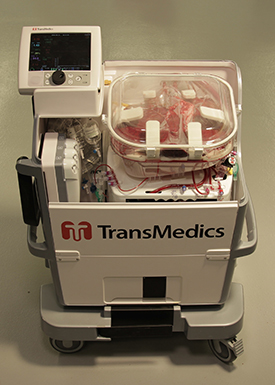Office of Research & Development |
 |
Office of Research & Development |
 |
January 24, 2020

The image shows a donor liver being kept viable for transplant with a device developed in part by VA researchers. (Photo courtesy of TransMedics)
VA researchers and colleagues invented technology that will increase the number and effectiveness of organ transplants. Working with the company TransMedics, Inc., VA researchers developed a technique called "warm perfusion," which keeps donor hearts and other organs alive using an artificial circulatory system, until they can be transplanted.
The donor organ is connected to a warm perfusion device that pumps a continuous supply of oxygenated blood and electrolytes, while the organ is outside the human body. The device also maintains temperature and pressure within the organ. The technique was patented by VA and licensed to TransMedics, which developed the technology.
TransMedics makes warm perfusion machines for heart, lung, and liver transplants. The heart and lung machines are approved for use in the United States by the Food and Drug Administration, while the liver machine is currently in clinical trials.
In a U.S. first, Duke University surgeons in 2019 used warm perfusion to revive a heart and transplant it into a patient. The transplant recipient was a U.S. Veteran who received the heart through the MISSION Act. The procedure was first performed in the United Kingdom in 2015. Warm perfusion has now been used multiple times in Australia and parts of Europe.
Many transplant organs come from organ donors who are declared brain-dead. Once family consent is obtained, machinery is used to keep the donor's heart pumping, by oxygenating the blood. After an organ is surgically harvested, it is typically placed into cold storage until it can be transplanted into a host. However, organs deteriorate rapidly on cold storage. Without this new technology, donor tissues are only viable outside the body from six to 30 hours, depending on the type of organ. Warm perfusion extends this time from six hours to 12 hours for donor hearts.
By lengthening the time that donor organs can be transplanted, the new technology could dramatically increase the supply of donor organs. Over 100,000 patients in the United States are on the waitlist for new organs. Because the supply of donated organs is limited, many patients die while waiting for a transplant.
Principal investigators: Dr. Waleed Hassanein, TransMedics, Inc.; Dr. Shukri F. Khuri, VA Boston Healthcare System; Dr. Michael Crittenden, VA St. Louis Healthcare System; Dr. Vladimir Birjiniuk, Mt. Auburn Hospital, VA Boston Healthcare System
Research partners: TransMedics, Inc.
Patents:
Hassanein W, Khuri SF, Crittenden MD, Birjinuik V, inventors. The United States of America as represented by the Department of Veterans Affairs, assignee. Compositions, methods and devices for maintaining an organ. United States patent US 6,953,655 B1. 2005 Oct. 11.
Hassanein W, Khuri SF, Crittenden MD, Birjinuik V, inventors. The United States of America as represented by the Department of Veterans Affairs, assignee. Compositions, methods and devices for maintaining an organ. United States patent US 8,409,846 B2. 2013 April 2.
Selected publications:
Continuous perfusion of donor hearts in the beating state extends preservation time and improves recovery of function. Hassanein WH, Zellos L, Tyrrell TA, Healey BA, Crittenden MD, Birjiniuk V, Khuri SF. Journal of Thoracic and Cardiovascular Surgery. 1998 Nov;116(5):821-830.
Doctors pump new life into dead donor heart in US first. Sparks H. New York Post. Dec. 2, 2019.
Heart from dead donor revived, transplanted into veteran in US first. Farber M. Fox News. Dec. 3, 2019.
Doctors restore heart from dead donor outside the body. Digon S. International Business Times. Dec. 3, 2019.
Donated organs kept ‘alive’ may ease the transplant shortage. Bernstein L. Washington Post. May 22, 2016.